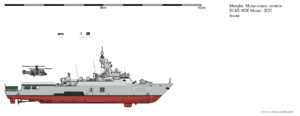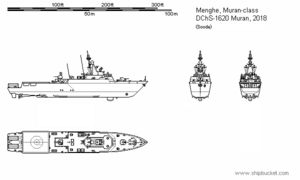Muran-class corvette
 Side view of DChS-1620Muran in 2022.
| |
| Class overview | |
|---|---|
| Operators: | |
| Preceded by: | Sŏwicho-class corvette |
| Built: | 2015-present |
| In commission: | 2017-present |
| Planned: | 30+ |
| Building: | 6 |
| Completed: | 21 |
| General characteristics (Muran, as built) | |
| Type: | Corvette |
| Displacement: | 1,600 tons |
| Length: |
|
| Beam: |
|
| Draught: | 3.6 m to keel |
| Propulsion: | |
| Speed: | 24 knots |
| Range: | 2,160 nautical miles (4,000 km) at 15 knots |
| Complement: |
|
| Sensors and processing systems: |
|
| Electronic warfare & decoys: |
|
| Armament: | |
| Aviation facilities: | landing pad for GH-28 or smaller helicopter |
The Muran-class is a type of light anti-submarine corvette built in Menghe during the 2010s. It specializes in detecting and engaging underwater targets, including mines and divers, in coastal areas. It also has a secondary minelaying capability, to compensate for the removal of mine rails on many post-2000 Menghean warship classes. It is also the first Menghean warship class to feature a "mission module" system, with space on the quarterdeck for 20' containers carrying optional equipment for additional capabilities.
Development
The Muran class was developed as a successor to the widely-built Sŏwicho-class corvette. Though built in large numbers and widely exported, the Sŏwicho design was starting to age by 2010, particularly in regard to its sensor fit and use of HBDJ-21/12 depth charge projectors.
While in development, the Muran class ran into a number of roadblocks, resulting in delays and cost overruns. Some leading doctrinal planners questioned whether the coastal anti-submarine role was best left to helicopters, which could cover more ground and attack submarines with impunity. After the design team responded by adding mine warfare capabilities and a modular mission bay, they encountered resistance from conservative thinkers in the Navy's upper echelons, who favored greater specialization in ship design and feared that a modular mission bay would result in inefficiency.
Design
The Muran-class corvette is designed around three core missions, namely:
- Defense of naval bases and port facilities against undersea threats;
- Protection of coastal surface combat groups against undersea threats; and
- Laying, maintenance, and clearing of coastal minefields.
The undersea threats it is designed to face include diesel-electric submarines, light submersibles, divers, remote undersea vehicles, trained animals, and various types of naval mines. As such, it has a highly capable hull-mounted sonar suite, consisting of an active-passive medium-range medium-frequency sonar, and a retractable high-frequency active sonar specialized in the anti-saboteur role. Speed, endurance, and seakeeping are limited, as the ship is only designed to make short patrols in coastal waters. Unlike the Sŏwichos, the Murans do not normally carry anti-ship missiles, but they can be fitted with an anti-ship missile module on the quarterdeck or helipad.
The helipad is another major difference with the preceding Sŏwicho class. It is large enough to support the launching and recovery of a single GH-28 or GH-30 helicopter, and it can also be used to launch and recover unmanned aerial vehicles. Because there is no onboard hangar, a helicopter can only be embarked temporarily and in good weather, or it can land to refuel and rearm before continuing its mission. These helicopters would be attached to the coastal installation being defended, or assigned to Muran-class ships escorting an outbound surface action group. The helipad is also useful for receiving supplies and evacuating casualties.
The space underneath the flight deck is left empty, except for mooring equipment, movable gangways, and four pairs of rails running forward to aft. These can be used to carry naval mines and deploy them off the stern. The internal rails can also support mission modules in 20-foot ISO containers. There is space for two modules on the open quarterdeck, four modules in the mission bay area, and two more which can be attached on top of the helipad, at the cost of limiting the helipad to small drone operations. A display at the Sunju Naval Technology Exposition in 2019 listed the following module sets:
- Enhanced submarine detection 1 (towed array sonar module, electronics module, operator module)
- Enhanced submarine detection 2 (variable-depth sonar module, electronics module, operator module)
- Mine clearance 1 (remotely piloted minehunting sonar module, electronics module, operator module)
- Mine clearance 2 (mine defusing UUV module, operator module)
- Anti-shipping 1 (missile module (4 × YDH-26), operator module)
- Anti-shipping 2 (missile module (16x YGJ-82), operator module)
The ship's powerplant consists of four Samsan 8EY26W 2560-kW eight-cylinder inline diesel engines in a two-pair CODAD arrangement. These are staggered between two engine rooms, so that the ship can still run on half power and one shaft if damaged by a mine. On each engine set, a power take-off system linked to a generator allows the ship to power its onboard systems from the main engines. Three additional Samsan 6EY18ALW 750 kWe diesel generators provide extra power, and a degree of redundancy. A tunnel thruster forward helps in docking and maneuvering.
Tactics
Unlike the Mirun-class and Yungju-class corvettes, which are designed to conduct independent long-range ocean patrols, the Muran and Sŏwicho-class corvettes are intended to operate close to shore. Typically, one squadron of three or four ships is assigned to a strategic coastal target, such as a major shipping hub or naval base. The ships then take turns patrolling the approaches to the harbor, searching for submarines, saboteurs, and mines planted near safe entry and exit routes. A three-ship squadron keeps one ship on patrol at any given time, and increases this to two during surge operations; a four-ship squadron keeps two ships on patrol at any given time.
When two Muran-class corvettes are operating in tandem, they coordinate their movements to detect submarines more effectively. A common tactic involves having one ship move while emitting active sonar, as the other waits in passive mode. Alternatively, both ships may rely on passive sonar, in order to triangulate the location of a submarine based on two bearing-only readings. These tactics are particularly effective in confined inlets, where it is difficult for an intruding submarine to move out of the patrol's irregular path.
Typically, a coastal facility with a permanently attached Muran or Sŏwicho squadron would also have a squadron of land-based anti-submarine helicopters, a detachment of light anti-saboteur patrol boats, and a network of permanent hydrophone arrays laid on the seabed, making the corvettes one element of an overlapping layered defense.
Ships in the class
The table below shows all Muran-class corvettes which have been laid down, launched, or commississioned, as of the end of 2021. In keeping with the tradition set by the Jangmi, Mugunghwa, and Sŏwicho-class corvettes, the Muran-class corvettes are named for plant species.
| Hull no. | Name | Mengja | Builder | Laid down | Launched | Commissioned | Status |
|---|---|---|---|---|---|---|---|
| Menghe | |||||||
| DChS-1620 | Muran | 木蘭 | Kimhae | 2015-02-02 | 2016-04-09 | 2017-10-30 | Active |
| DChS-1621 | Odong | 梧桐 | Kimhae | 2015-06-01 | 2016-09-09 | 2018-04-03 | Active |
| DChS-1622 | Baekrabsu | 白蠟樹 | Gyŏngsan | 2015-06-15 | 2016-10-27 | 2018-05-28 | Active |
| DChS-1623 | Chajŏncho | 車前草 | Gyŏngsan | 2015-09-24 | 2016-10-27 | 2018-06-08 | Active |
| DChS-1624 | Jajuk | 紫竹 | Kimhae | 2016-02-25 | 2017-06-02 | 2018-11-02 | Active |
| DChS-1625 | Yŏnchunhwa | 迎春花 | Kimhae | 2016-04-10 | 2017-08-01 | 2019-02-20 | Active |
| DChS-1626 | Hunyicho | 薰衣草 | Kimhae | 2016-05-13 | 2017-10-07 | 2019-04-10 | Active |
| DChS-1627 | Juksun | 竹筍 | Kimhae | 2016-09-13 | 2017-12-20 | 2019-06-09 | Active |
| DChS-1628 | Banhonghwa | 番紅花 | Gyŏngsan | 2016-10-30 | 2018-03-22 | 2019-11-08 | Active |
| DChS-1629 | Sanchahwa | 山茶花 | Gyŏngsan | 2017-01-07 | 2018-04-24 | 2019-11-14 | Active |
| DChS-1630 | Dosu | 桃樹 | Kimhae | 2017-01-11 | 2018-07-06 | 2020-02-27 | Active |
| DChS-1631 | Gongtong | 珙桐 | Kimhae | 2017-06-05 | 2018-08-05 | 2020-04-05 | Active |
| DChS-1632 | Gŭmŭnhwa | 金銀花 | Kimhae | 2017-08-03 | 2018-11-15 | 2020-06-18 | Active |
| DChS-1633 | Suguhwa | 繡球花 | Kimhae | 2017-10-10 | 2018-12-30 | 2020-07-01 | Active |
| DChS-1634 | Chasu | 茶树 | Kimhae | 2017-12-26 | 2019-03-08 | 2020-11-20 | Active |
| DChS-1635 | Bongsŏnhwa | 鳳仙花 | Kimhae | 2018-07-09 | 2019-09-29 | 2021-01-25 | Active |
| DChS-1636 | Aenghwacho | 櫻花草 | Kimhae | 2018-08-09 | 2019-10-09 | 2021-04-19 | Active |
| DChS-1637 | Rapalhwa | 喇叭花 | Kimhae | 2018-11-17 | 2020-01-02 | 2021-06-30 | Active |
| DChS-1638 | Okranhwa | 玉蘭花 | Kimhae | 2019-01-05 | 2020-04-12 | 2021-10-10 | Active |
| DChS-1639 | Hwangdu | 黃豆 | Kimhae | 2019-03-11 | 2020-05-25 | 2022 | Fitting out |
| DChS-1640 | Mopodong | 毛泡桐 | Kimhae | 2020-05-26 | 2021-07-17 | 2023 | Fitting out |
| DChS-1641 | Chijahwa | 梔子花 | Kimhae | 2021-07-05 | 2022 | 2024 | Under construction |
| DChS-1642 | Mugunghwa | 無窮花 | Kimhae | 2020-05-26 | 2022 | 2024 | Under construction |
| Medacapre | |||||||
| Kimhae | 2019-10-13 | 2020-12-30 | 2022 | Fitting out | |||
| Kimhae | 2020-04-17 | 2021-07-02 | 2023 | Fitting out | |||
| Kimhae | 2021-01-04 | 2022 | 2024 | Fitting out | |||
| Kimhae | 2022 | 2023 | 2025 | Fitting out | |||
